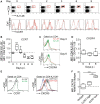In vivo TCR Signaling in CD4(+) T Cells Imprints a Cell-Intrinsic, Transient Low-Motility Pattern Independent of Chemokine Receptor Expression Levels, or Microtubular Network, Integrin, and Protein Kinase C Activity
- PMID: 26106396
- PMCID: PMC4459086
- DOI: 10.3389/fimmu.2015.00297
In vivo TCR Signaling in CD4(+) T Cells Imprints a Cell-Intrinsic, Transient Low-Motility Pattern Independent of Chemokine Receptor Expression Levels, or Microtubular Network, Integrin, and Protein Kinase C Activity
Abstract
Intravital imaging has revealed that T cells change their migratory behavior during physiological activation inside lymphoid tissue. Yet, it remains less well investigated how the intrinsic migratory capacity of activated T cells is regulated by chemokine receptor levels or other regulatory elements. Here, we used an adjuvant-driven inflammation model to examine how motility patterns corresponded with CCR7, CXCR4, and CXCR5 expression levels on ovalbumin-specific DO11.10 CD4(+) T cells in draining lymph nodes. We found that while CCR7 and CXCR4 surface levels remained essentially unaltered during the first 48-72 h after activation of CD4(+) T cells, their in vitro chemokinetic and directed migratory capacity to the respective ligands, CCL19, CCL21, and CXCL12, was substantially reduced during this time window. Activated T cells recovered from this temporary decrease in motility on day 6 post immunization, coinciding with increased migration to the CXCR5 ligand CXCL13. The transiently impaired CD4(+) T cell motility pattern correlated with increased LFA-1 expression and augmented phosphorylation of the microtubule regulator Stathmin on day 3 post immunization, yet neither microtubule destabilization nor integrin blocking could reverse TCR-imprinted unresponsiveness. Furthermore, protein kinase C (PKC) inhibition did not restore chemotactic activity, ruling out PKC-mediated receptor desensitization as mechanism for reduced migration in activated T cells. Thus, we identify a cell-intrinsic, chemokine receptor level-uncoupled decrease in motility in CD4(+) T cells shortly after activation, coinciding with clonal expansion. The transiently reduced ability to react to chemokinetic and chemotactic stimuli may contribute to the sequestering of activated CD4(+) T cells in reactive peripheral lymph nodes, allowing for integration of costimulatory signals required for full activation.
Keywords: CCR7; CD4+ T cell migration; PKC; T cell activation; lymph node; stathmin.
Figures





References
Grants and funding
LinkOut - more resources
Full Text Sources
Other Literature Sources
Research Materials

